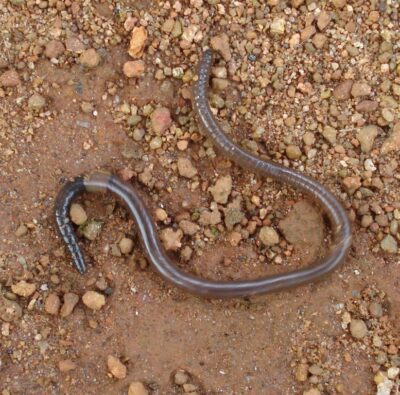
BY HARRY WEEKES

We are in a global pandemic. Stories of systemic and structural racism build and thrive. The economy, with many of its various sectors in shambles, seems precarious at best. Latest long-term climate projections are grim. And I cannot get earthworms off my mind. It might actually be because of all of these things that they are even on my mind.
You see, I have been stewing, and brooding, and spending more time looking at the ground than looking into the sky (there is an interesting psychological piece in here: “Why do people tend to look down when they are worrying over something?”).
At first, the dark little mounds emerged as a kind of mottled backdrop to where I was walking. My attention to them moved up in various levels. Initially, I simply wondered if they were artifacts of recent rain, or some kind of critter footprints left in the soft dirt.
Their spacing changed something, though. Relatively uniformly spread out, I went from “stuff on the ground” to “hmmm, what is that stuff on the ground?” It was obvious, even at my loping gait, that the little mounds were excavations—little piles of dirt displaced from the holes. What also became obvious, the mounds were pushed out, not dug out. In other words, this was something coming up from inside the earth, not trying to get back in.
“Aha! Earthworms!”
Regularly spaced throughout the little trail were tiny mounds of fresh dirt pushed to the surface by earthworms. These mounds are called castings, and mark the handiwork of a thriving earthworm population, whose geophysical impact is nothing short of astonishing (a low estimate on the number of worms I saw was five or so per cubic foot. This many worms bring up hundreds of pounds of topsoil every year, moderate the pH of and aerate the soil, and are responsible for the churning of all sorts of micronutrients and macronutrients throughout the closest horizons.).
All of this, and these muscular little tubes are constantly working in the lightless world beneath our feet, literally chewing (this might not be the best verb for something that doesn’t have teeth) their way through the ground.
Just as I started wondering about the other complexities of their lives, there they were—two worms, each stretched out of its tunnel, glued together in the most descriptive and simple biological term I have come across recently—a slime tube. Earthworms are hermaphrodites—having both sexes present—and they are sexual, so rather than breeding with themselves, they breed with any other worm of their species they come across (a pretty sensical strategy in the world in which they live).
There they were, wrapped in an amorous slime tube, oblivious, I thought, to my appreciation. My next footfall arrived with all of its associated tremors, and the worms vanished—two rubber bands snapped into their holes. Gone in an instant. I stood and looked, the holes no longer empty in my mind.
Needless to say, my thoughts gradually turned back to the human world and all that we are going through. The worms smoothed an edge, though. They gave me a glimpse into something outside of all of my worries. It is for this micronutrient, one I keep forgetting, that I am most grateful.
Harry Weekes is the founder and head of school at The Sage School in Hailey. This is his 48th year in the Wood River Valley, where he lives with Hilary and two of their three baby adults—Penelope and Simon. The other member of the flock, Georgia, is currently fledging at Davidson College in North Carolina.
